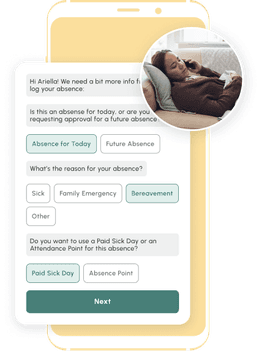
Discover the essentials of employee call-in procedures in our latest blog post. Learn about call-in policy examples and best practices in 2024.
by Sheila Stafford CEO, TeamSenseFix the root cause of No-Call No-Show with TeamSense Book a Demo
Fix the root cause of No-Call No-Show with TeamSense
Unplanned absences are a reality in any workplace, and the numbers tell the story. In 2022, the U.S. Bureau of Labor Statistics reported that 3.4% of manufacturing workers and 3.6% of warehousing employees were absent from work. But these numbers aren't just statistics: they represent real challenges that you, as an employer or supervisor, must navigate regularly.
So, what's the solution to this common challenge? A clear, well-defined employee call-in procedure. A great employee call-in procedure can be the difference between a timely, productive workforce and a mountain of no-call no-shows and shift changes to manage.
In this blog post, we'll delve into the types of employee call-ins, the important elements that make up a comprehensive call-in policy, and best practices for creating and implementing your employee call-in procedure. We'll also provide a call-in policy example you can work off of so you can improve your call-in procedures and ultimately reduce absenteeism at your organization.
Employee call-in or call-out refers to the process in which an employee notifies their employer or supervisor they are unable to attend work as scheduled or need to request time off for a specific period. These calls can be due to various reasons, such as illness, personal emergencies, medical appointments, or unexpected events.
Employees “call in” through designated communication channels, whether that be phone calls, emails, text messages, or absence management software.

Ever been caught in the "call in" vs. "call off" vs. "call out" debate? They can be a bit of a puzzle, so let's clear that up
Call In
Traditionally, to "call in" means for an employee to notify their employer that they will not be able to attend work as scheduled. It's a proactive measure taken by the employee to inform their supervisor or designated contact point about their unexpected absence, often due to reasons like illness, personal emergencies, or other unforeseen circumstances. It's a term that underscores the responsibility on the part of the employee to communicate effectively.
Call Off
"Call off" is sometimes used interchangeably with "call in," but it can also be associated with the cancellation of work by the employer. For instance, if there's not enough work for the day or due to weather-related issues, an employer might "call off" a shift, indicating that the employee should not come in or that the workplace will be closed.
Call Out
While "call out" can also be used synonymously with "call in," it may have a different connotation in some regions or industries. In some cases, "call out" can imply the act of reporting an absence in a more urgent or unplanned situation, such as a last-minute emergency that prevents an employee from coming to work.
In a nutshell: Whether you're "calling in" with a heads-up or "calling out" in a crunch, what matters is you're keeping the lines of communication crystal clear. And if the day's "called off" by the powers that be, well, that's just a bonus. Just make sure your workplace handbook spells out these terms so everyone's singing from the same song sheet. No more mix-ups!
An employee call-in procedure is a set of guidelines that employees should follow when they need to report an unexpected absence or a late arrival. They should cover who to call off to, when to call in by, and whatever information is required for HR to manage these requests. Having a clear and consistent call-in procedure can help employers manage their workforce, reduce employee no-call no-shows, and ensure compliance with labor laws.
It can also help employees understand their attendance responsibilities and avoid disciplinary actions or any misunderstandings.

Now that we’ve gone over the basics of what employee call-in means, we’ll now cover some reasons employees may need to call in.
This is one of the most common types of call-ins. Studies show that 72% of the total absence rate in 2022 was due to illness or injury. Employees might call in sick due to illness, injuries, or even stress.
Emergencies can arise at any time, such as sudden family crises or medical emergencies.
Unscheduled late arrivals refer to instances when employees arrive at work later than their scheduled start time without prior notice or approval. An estimated 20 percent of workers are regularly late to work, costing U.S. businesses around $3 billion each year.
While call-ins usually refer to unplanned absences, some organizations may still include instructions for reporting scheduled absences within their call-in policy. A scheduled absence refers to a planned and pre-approved time period during which an employee is not expected to be present at work. These absences may include vacations, personal days off, medical appointments, or other approved reasons for being away from work.
Incorporating the Family and Medical Leave Act (FMLA) into your call-in procedures is about blending compassion with compliance. Here's how to weave it into your policy without getting tangled up.
Understanding FMLA Basics: FMLA allows eligible employees to take unpaid leave for specific family and medical reasons with the continuation of group health insurance coverage. When it comes to call-ins, employees should inform their employer as soon as possible if they need FMLA leave.
Seamless Integration: Start by training your team on FMLA essentials – who's eligible, how it works, and what rights and responsibilities both the employer and employee have. Ensure everyone knows that FMLA leave should be clearly stated when they call in, with details on the timing and expected duration of the leave if known.
Set Clear Expectations: Your call-in policy should specify how an employee can request FMLA leave. This includes who to contact, how much notice is required, and what information needs to be provided. For example, a simple sentence like, "If you're calling in for FMLA leave, please let us know immediately, and we’ll guide you through the next steps."
Document, Document, Document: Keep meticulous records of all FMLA call-ins. Documentation is your best friend in maintaining compliance and helping your team navigate their leave smoothly.
Be Proactive: Encourage employees to communicate their need for FMLA leave as early as possible. If it's foreseeable, a 30-day heads-up is ideal. If not, as soon as they can is the way to go.
Keep it Flexible: Sometimes life happens without warning. Be ready to handle last-minute FMLA call-ins with a process that's fair and understanding but still sticks to the legal script.
Remember, every workplace is unique, so tailor your FMLA call-in procedures to fit the fabric of your organization. And when in doubt, reach out to an HR professional or legal expert to ensure your policy is up to code.